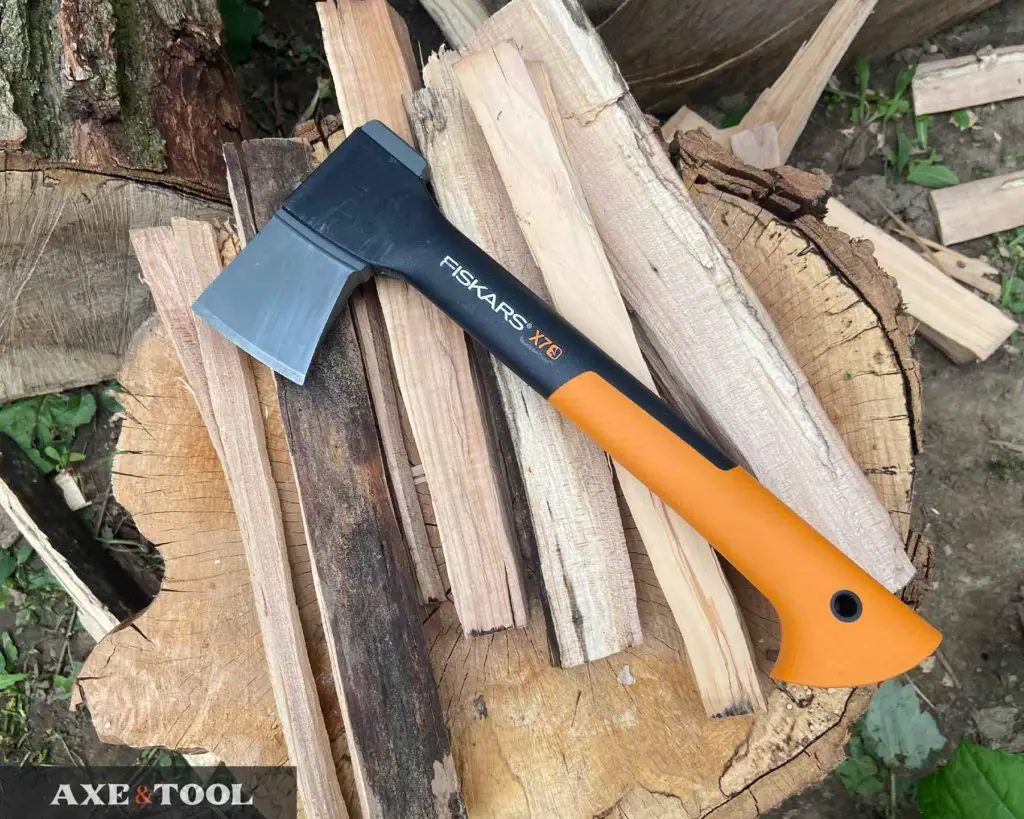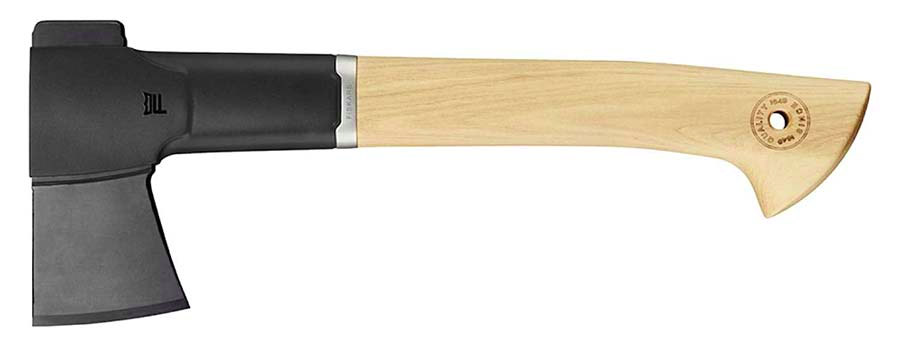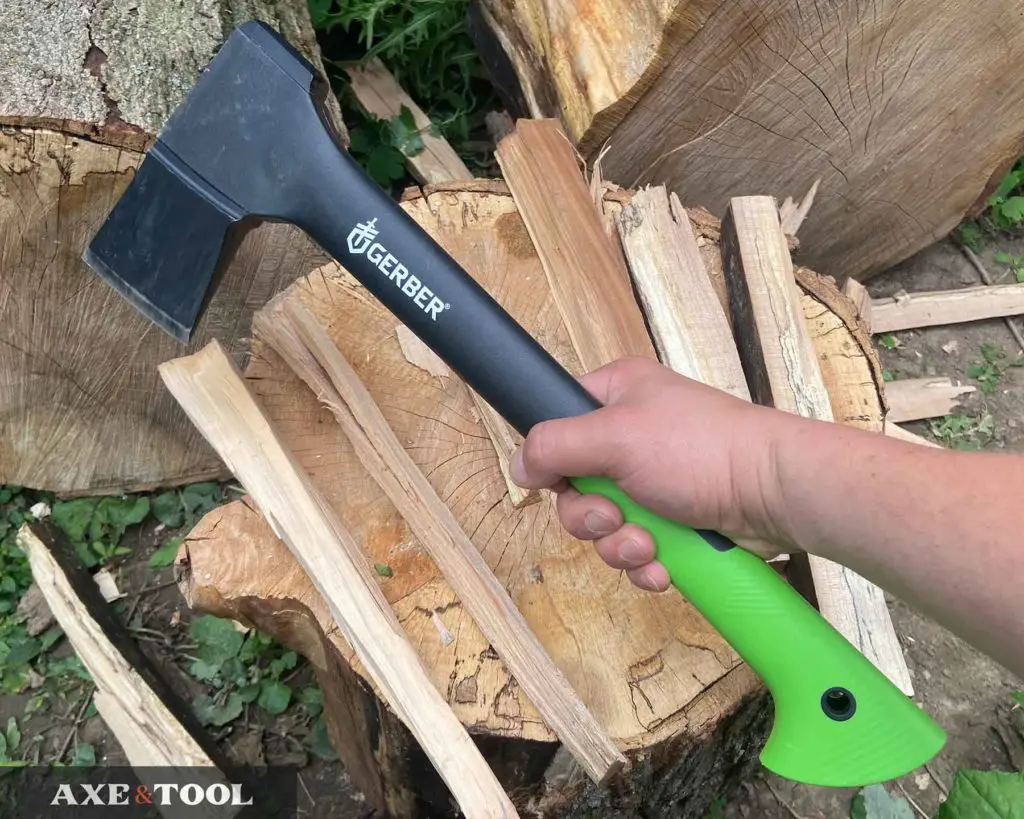
Fiskars is a great choice If you need a kindling hatchet for the homestead, cottage, or camping. But Fiskars offers many options, and it’s not always clear what the best choice is.
I tested the Fiskars X5, X7, X10, X11 and compared a few alternative versions of these models.
While I think there is a clear winner for a dedicated kindling hatchet, there are some serious alternatives that can do quite a bit more and still be a decent kindling tool.
Table of Contents
The Fiskars X7 is ideal for kindling
The 14” X7 is the best overall Fiskars hatchet for kindling. The stout wedge pattern head pops wood apart, and the handle is short for close work but long and tough enough to pry twisted grain apart. However, you might consider other models that can handle kindling and also flex into other rolls.
The X7 is small, light, and a great all-around hatchet. It can be handled easily by new and experienced users alike and is surprisingly capable in this role. It can split 4.5-5 inch pieces pretty easily. So you don’t need to worry about which log you start making kindling from.

The X7 head splits well
The wide-angle of the short wedge shape helps pop the grains apart quickly with less penetration than a traditional hatchet. This can mean less power is needed and you can be more accurate.
Longer thinner blades can be better for other tasks but have the potential to stick when splitting vertically.
Fiskars axes also come quite sharp for an inexpensive axe. There is a uniform 30-degree edge that will cut in for smaller tinder, even if the head shape isn’t suited for slicing.
The X7 handle length is perfect for splitting kindling
The tough 14-inch nylon handle is long enough to get leverage and act as a pry bar If you take on a piece of wood that is a little too big or has twisted grain. It won’t be damaged.
The length is also an ideal distance away for kindling, as it’s easy to keep aim and be precise. While its total length is 14” (13.875 to be precise), the last inch gets taken up by the massive hook on the bottom, so it handles like a 13”.
I’m not complaining about the hook – it’s one of the best features of the entire Fiskars line. It keeps your hand locked in the axe.
Making tinder with a Fiskars X7
If you need to get down to the really small stuff (like tinder), you may wish you had a thinner blade. They are sharp enough, but the wide wedge tends to break off strands before you can get them very long. So shaving tinder or making a feather-sticks is a little trickier.
X7 vs 14” Black Chopping Axe

The Fiskars X7 and Black 14” hatchet (A6) are essentially the same hatchets except for the overmold grip on the X7. The head size and performance of these axes are identical but the overmold does improve the grip and perceived vibration.
I would get the X7. I was originally skeptical but the over-mold does make a difference, and the price is almost identical.
Gerber Freescape 14

Gerber is owned by Fiskars. This is the same axe with a green handle and black blade, BUT the Gerber also comes with a lighter pack-focused sheath for the woods. The X7 can come with the pack sheath, but I’ve found it usually has the older wall hanger sheath.
If you like Green and want to make sure you get the pack sheath I would go Gerber – but be aware it’s often $5-$10 more than the X7. Check the Gerber on amazon.
Fiskars Norden N7 vs X7

The Fiskars N7 has the same head and overall length as the X7, but it has a hybrid composite/wood handle. The nylon upper handle provides the standard Fiskars durability while the lower handle wood offers a traditional feel in hand.
While I love the feel of a wood handle, the price would make me pick the X7 every time. The X7 is like $40, and the N7 is like $90 (see on amazon). But it offers identical performance and is certainly an option if it speaks to you.
Fiskars X11 is for the woodpile

The X11 should be a serious contender for anyone with a homestead or cottage that keeps and uses a woodpile.
As the smallest Fiskars splitting axe, it’s just shy of 17.5” long with roughly a 2lb flared splitting head. This axe can flex between one-handed use for kindling and two-handed use splitting larger logs. It can go up to about 8″ wide logs.
The extra weight in the head helps split kindling and even tinder. An easy tap will usually get things started. You won’t need big swings to pop small pieces apart.
Why isn’t the X11 my first choice?
Originally, I thought the X11 was going to be a no brainer – but after a summer of testing I found I kept wanting to use the X7.
The X11 is powerful for big swings, but can be awkward working one-handed close up. The larger head can feel clumsy when working with small pieces. Even a light swing is harder to aim than the X7 and the inertia carries much further. It feels a bit like overkill if you are making kindling from typical pieces of pre-cut firewood (at your campsite or fireplace).
It will easily blow through typical kindling size wood and has more potential to be dangerous to less experienced users. The blade could find your other hand or your shins very easily if used incorrectly.
As evidence – I cut my thumb with this axe like a dumbass processing kindling, ONE DAY AFTER I finished this article.
But, if you like the idea of having more power if needed – The X11 worth considering. (See on Amazon).
X10/Gerber Freescape 17.5 for the wilderness
The actual X10 doesn’t seem to be sold in North America, just the Gerber branded Freescape 17.5. These axes are identical (again Gerber is owned by Fiskars).

The X7 is probably the better for basic car camping – where your wood comes pre-cut and you might just need to pop a few pieces apart for kindling. The X10 is more of a forest axe and chopper that can also be a kindling maker.
It’s 17.5” (ish) in length and can be used one or two-handed. The larger head is uniquely longer and thinner than all the other Fiskars axes, making it well suited for the wilderness and bushcraft. It’s a very versatile chopper.
Similar to the X11 it’s a little too big and awkward for a dedicated kindling hatchet. You will often find yourself holding mid-handle and the larger blade feels like overkill for smaller pieces.
So this is a good option if you want a more capable axe for camping, or around the property that can do more serious chopping and kindling. I just wouldn’t pick it for kindling specifically.
This axe can be harder to find in store, since it’s more “Bushcrafty”. I bought mine on Amazon (see here).
Fiskars X5 pack axe

This little pack hatchet is surprisingly good at splitting too. It uses the same head as the X7, it just has a shorter overall length of 9.5 in. It’s my first choice for backpacking (often even over some of the more expensive options). It only weighs 0.56kg (1.3lbs), which makes it the lightest “real” axe out there. (see my article X5 vs Gerber Pack Axe)
In testing, it was splitting 4-inch pieces of firewood easily, just like the X7. However, there are 2 reasons I would pick an X7 over the X5 if you can take the size:
- zzzThe handle is too short to be effective prying wood apart if it doesn’t split fully on the first hit, or if the grain is twisted.
- There is always a certain fear for your knuckles when splitting larger pieces. You need to swing hard enough that it would hurt if your aim was off.
The hook at the bottom is smaller than the other models so you can hold that in a half-hand manner and get a little more clearance. But the hollow end of the handle can dig into your palm and isn’t super comfortable for extended use this way.
So if size and weight are the most important factors – then this is a capable little hatchet. But I would go for the X7 if possible.
The X5 can be harder to find, even on amazon (try here). But, there is a black Gerber branded version that is identical to the X5 (it’s made by Fiskars) which can sometimes be easier to find in USA/Canada. Here is the alternate Gerber 9 on amazon.
Avoid the Gerber Gator, which looks like, but is not a Fiskars. Gerber Gator axes are lower quality and made in Thailand).










































